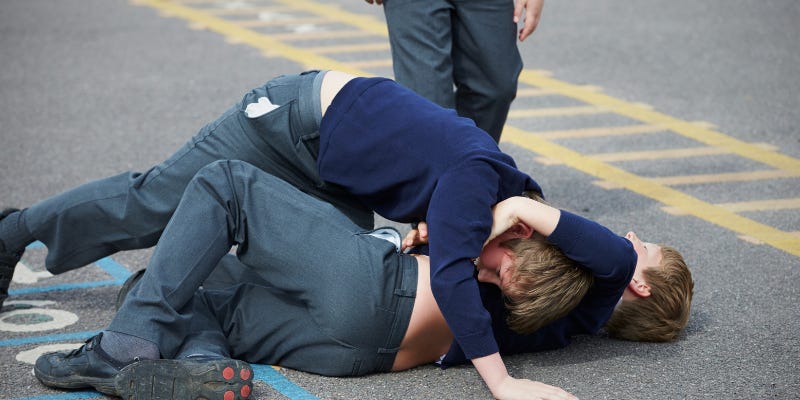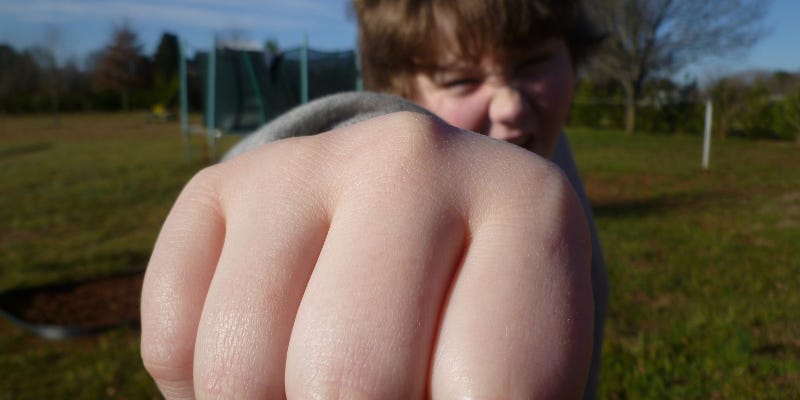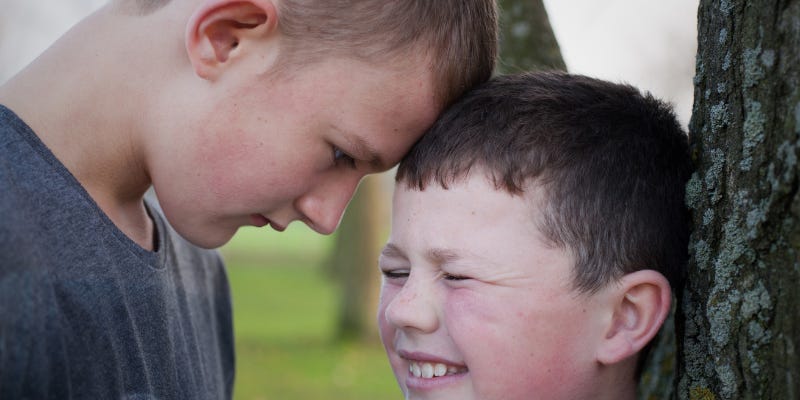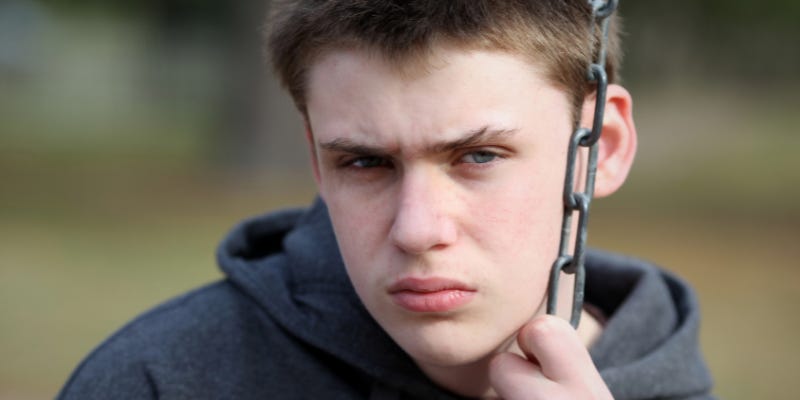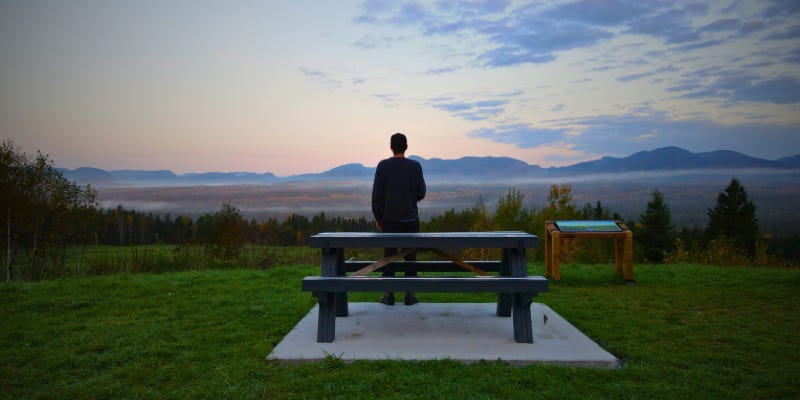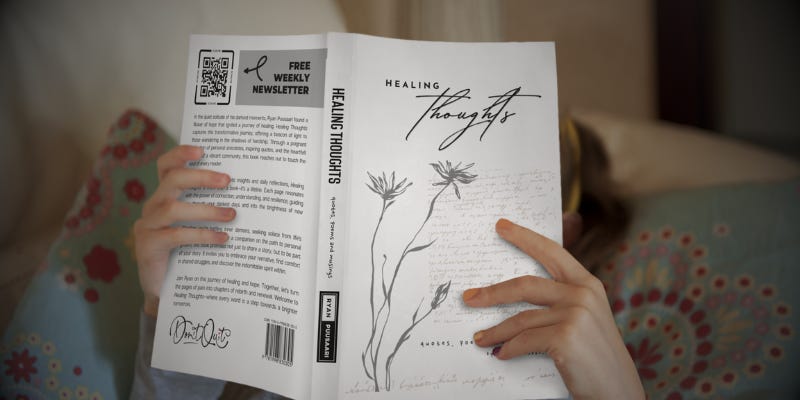the devil in the schoolyard
The world is full of wolves, but when you learn to survive, you stop being their prey.
NOTE: This is the 5th edition of the Live Out Loud series. To view the full series please visit the table of contents. Make sure you never miss an issue, hit the subscribe button below.
My first face-off with the beast called bullying happened when I was six years old. Back when I still thought the world was kind, and people played fair.
I was in first grade.
Some kids—self-appointed kings of bad decisions—wanted me to join their little crime spree. Shoplifting. They didn’t ask; they expected.
And me, I hesitated.
Maybe it was fear, or maybe it was that tiny voice in my head whispering, “Don’t.”
Turns out, saying no wasn’t an option.
Suddenly, I was a target.
Branded “wimp” for not jumping on their reckless bandwagon. And just like that, their teasing turned into something darker. Constant. Relentless.
That’s how it started.
My crash course in the ugly truth of bullying.
I was six, wide-eyed and too small for the mess I was walking into.
Tagging along with a crew of schoolyard “friends,” all of them pros in the art of shoplifting. They stuffed their pockets with stolen candy, grinning like they owned the place.
Me, I stood there, heart pounding, guilt gnawing at my gut.
I grabbed a single piece of five-cent gum, shaking, my minor crime looking pitiful next to their stash.
But guilt hit me hard.
That tiny piece of gum felt like it weighed a ton in my pocket. By evening, I couldn’t take it anymore. I marched back to the store, dropped a quarter on the counter, bought four packs of five cent gum I didn’t even want, and told the shopkeeper to keep the change.
Then came Halloween.
The day of candy, costumes, and harmless scares. But that year it turned into my personal nightmare.
The school bell rang, and while everyone else buzzed with excitement, I was about to walk straight into hell. Dressed as the devil—how fitting—I didn’t realize I was stepping into a pit of vipers.
Around me, witches, superheroes, and skeletons swarmed the playground.
The air was filled with laughter. Joking. The usual.
But I couldn’t shake the knot twisting in my gut.
And then I saw them.
The same boys. The ones I had once called friends, back when they pulled me into their shoplifting scheme. They had shifted from petty thieves to something far darker—my tormentors.
One of them locked eyes with me.
The gleam in his gaze was not mischief but one of pure malice.
His fist clenched. And I saw it before I felt it. His punch shot through the air, straight at me, and boom—down I went. Crashed onto the cold, unforgiving ground.
Chaos erupted.
They circled me like a pack of wolves. Kicks rained down, one after the other. I tried to curl up, protect myself, but it didn’t matter.
I was caught in a cruel trick with no treat, no escape.
And then came the worst part. One of them grabbed my pitchfork—the plastic one I’d been carrying around all day.
He raised it above his head, and before I could even process it, the pitchfork came down. Hard. Straight into my right eye.
Pain. Blinding. Burning.
Blood poured out, pooling around me, turning the world into a swirl of red and darkness. I thought I’d lose the eye right then and there.
The disbelief washed over me like a wave. Is this really happening? To me?
But somehow, miraculously, my eye survived.
Barely.
What I couldn’t see coming were the bruises—both the ones on my face and the ones deep inside. Half my face turned black and blue, a mess of color and pain.
When the police got involved, I clammed up.
Silence was safer. I wasn’t about to snitch and risk worse. So I gave fake descriptions. Let the bullies walk away, free.
Was it cowardly?
Maybe.
But fear has a funny way of choking out your voice.
B.F. Skinner once said our behavior is shaped by our environment. Well, my environment was a battlefield. And trust became a casualty that day.
After that Halloween, friendships, people, all of it shattered into sharp, jagged pieces.
That day didn’t just bruise my face—it bruised my soul.
The innocence I had left was gone.
The Many Masks of Bullying
Bullying, I quickly learned, wears a lot of ugly masks. Verbal. Physical. Emotional.
Every day, the same kids at school, and some from the neighborhood, found new ways to tear me down. Their insults and jabs were meant to humiliate, to crush whatever bit of self-worth I had left.
My dad was clueless. His grand solution was to, “Just stay out of their way.”
Like I could hide when the battlefield was everywhere.
School was a daily war zone. Every morning, the dread hit hard, but I went anyway. What else could I do? A kid’s gotta go to school, even if it feels like walking into a trap every day.
Then something clicked.
Sarcasm became my secret weapon. I built my own language—sharp, biting, dark. My words turned into armor, laced with just enough sting to keep the bullies at bay.
It wasn’t out of bravery—it was survival.
I took their insults, twisted them, made them sharper. Then I turned them back on myself, like a punchline they didn’t see coming.
And it worked.
I left them standing there, confused, waiting for their satisfaction. But I’d already stolen it with a smirk and a one-liner.
Was it graceful?
Nope.
But was it effective?
Absolutely.
My sarcasm became my shield, my humor my sword. It was like clinging to a life raft in a sea of insults, not elegant, not pretty, but mine. My way of staying afloat when the waves of mockery kept crashing down.
Not the poetic solution, but the one that worked.
The Boiling Point
High school hit like a storm. Those seeds of bitterness that had quietly taken root were in full bloom now, twisting inside me, feeding on old grudges.
I wasn’t just mad—I was fueled by it.
Revenge became my go-to move. Petty thefts, confrontations—my way of speaking the only language I thought anyone understood.
But here’s the catch: none of it worked.
Each act of retaliation just left me emptier.
Lonelier.
I had “friends,” sure—a ragtag bunch that didn’t really care.
And I was stuck. Stuck in a loop that only dug me deeper into the isolation I was trying to escape. The more I lashed out, the tighter the walls closed in. It was like living in one of those grim Hobbesian tales—“solitary, brutish, and short,” except it felt like it’d never end.
Gone were the days when I thought the world was full of possibilities.
Those dreams I had, back when I’d stare at city lights from the escarpment, imagining some bright future had faded. Now, everything was smaller, darker.
My world had shrunk to a fight for survival. With no escape. No hope. Just me, trudging through, more alone than ever, in a world that felt less like a home and more like an enemy.
As Carl Jung once observed,
"The healthy man does not torture others - generally it is the tortured who turn into torturers."
Finding Refuge in Nature
Nature has always been my escape. My quiet refuge. A place to run to, whether I was bursting with joy or drowning in despair.
As a kid, my bike was my freedom, my chariot through winding woodland trails. Every ride felt like an adventure. Wild berries weren’t just snacks—they were little trophies, proof that I’d been out there, exploring, independent.
The trees watched over me like silent giants, and those afternoons, they were pure bliss.
By the time I hit my teens, my go-to spot was the edge of the escarpment. From up there, I could see the city sprawled out beneath me. A sea of lights twinkling like tiny stars. Each one seemed to be a sparkle of a promise. A dream.
The wind would carry my hopes with it, out into the world. Down below, the city looked like a canvas, waiting for me to paint my future on it.
Fast forward to adulthood, and waterfalls became my sanctuary. Standing there, in the mist, it felt like the world’s weight was rinsed off me. The spray filled the air with energy, with life. It wasn’t just water—it was renewal.
The sounds of the wild—the wind, the birds, the leaves dancing in the breeze—played like nature’s lullaby, calming my racing thoughts. In those moments, I could finally just be.
That’s when I started shadow work.
During my mid-thirties, feeling lost, I turned to Carl Jung’s teachings. I began journaling, diving into the darkest corners of my mind, confronting fears and old wounds.
I’d sit there, in nature, and write. The sun overhead or the moon rising, the earth beneath me—it all felt like an anchor, something steady while I unraveled.
The dew-soaked grass became my confession booth, the rustling trees my silent listeners. I scribbled my thoughts, my anxieties, my deepest fears. Letting it all out.
It was like I was having a conversation with the universe, putting everything out there for it to see. Cathartic. Necessary.
Nature’s rhythm mirrored my own healing process.
Just like the forest sheds its leaves, I let go of what no longer served me. Just like the river embraces the rain, I learned to accept the shadows within me.
Every journal entry, every moment spent in the wild, became a step toward healing. It wasn’t pretty or perfect, but it was real.
In the end, the trees, the waterfalls, the wind—they taught me that every part of me, even the messy, painful bits, belonged. Just like nature embraces both the sun and the storm, I found a way to accept all of myself.
That’s how I healed—by tuning into the world’s rhythms, and dancing along with my own.
Looking Back
Looking back now, it’s wild to see how deeply those experiences shaped me.
Trust—yeah, that’s been a mess.
I’ve had walls higher than skyscrapers, keeping people out, keeping me in. Making real connections felt like trying to climb Everest without gear.
Anxiety—oh, it was there, always lurking.
For years, I was my own little island—untouchable, unreachable.
But, strangely, not all bad came out of it.
The constant bullying forced me into my head, made me question everything, made me think. I became a master at peeling back the layers of human behavior, figuring out what made people tick. That pain birthed a resilience I didn’t even know I had. And slowly, I built a self-esteem that came from staring down my fears, one ugly day at a time.
The kid who got hurt, who felt small grew into a man, scarred but unbreakable.
I’m still working on it—every day, I try to carve out a safe space, not just for me, but for others, too. I share my story. My scars. My lessons.
Not just to heal myself, but to remind someone out there that they’re not alone. TikTok became my megaphone—where I shout back at bullying, where I show the world its nasty ripple effects.
Don’t get me wrong, I still wrestle with my ghosts.
Some days, they’re loud.
But when I’m out in nature, jotting down my thoughts, or speaking into a camera, I remember—there’s strength in me. I’ve survived. I’ve won battles I didn’t even know I was fighting.
If I could say anything to that scared little kid—the one who had no idea what was coming—I’d say this…
“Don’t let a few cruel people ruin your shot at love, trust, and real friendships. There’s more to life than them. You are not alone. And your worth is not measured by someone else’s words or fists. The storm feels endless, I get it, but remember—it will pass. They always do. No one deserves to feel like a devil in the schoolyard, haunted by someone else’s demons. Not then, not now, not ever. You are loved, you are seen, you are heard. I love you.”
—Ryan Puusaari
P.S. Your time and engagement with this edition mean a lot. Every reader adds value to our journey together. Thank you for being here!
P.P.S. “Bullies want you to feel alone, but their cruelty only isolates them more than anyone else.”
Healing Thoughts — A Journey of Reflection, Poetry, and Healing, Made Possible by You
Healing Thoughts isn’t just another book—it’s a living, breathing collection of reflections, inspiring quotes, and poetry, all pulled from the heart of this community.
Through the highs and lows, the moments of growth and vulnerability, your support made this book a reality.
Each page is a step toward healing, filled with wisdom, introspection, and emotional insight to guide you on your personal journey.
This book is more than just words—it’s our story.
Before You Go
Dive into the latest posts in the archives.
Learn more about me, this newsletter, or my daily texts.
Explore my journals and books over at Wood Island Books.
Follow me on social media for daily inspiration and updates.
Check out my recommended reading list for must-read books and authors.
View my exclusive merch collection—designed to inspire and uplift.
Have questions or thoughts? I am just an email away—reach out anytime.





